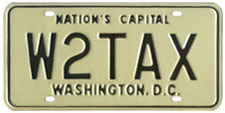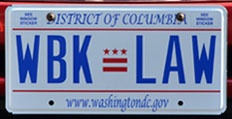Washington, D.C. Personalized Plates
Personalized license plates, also known as "vanity" plates, have a registration number comprised of letters and/or numbers chosen by the vehicle owner. Although usually considered a separate plate and registration type by plate collectors, personalized plates are considered part of the private passenger category by most DMVs including that of Washington, D.C. Since 1965 registrations of this type have always been issued for periods identical to those of other registration types (i.e. April 1 through March 31 annually until the expiration of registrations became staggered in 1983), but not until the late 1970s were personalized plates consistent in appearance with plates of other types.
It was during the mid-1960s that vanity plates were first made available in many of the states, and their debut in the District of Columbia came in late 1964, long before they were offered in Maryland (1971), Virginia (1972), and most other nearby states. The black-on-white plate style introduced that year and issued for more than a decade incorporated the wide dies used to make most D.C. plates in use at the time. Long after their use had been abandoned for all other plate types, however, they continued to be used to make personalized plates, resulting in five being the maximum number of characters allowed on each plate for many years. Not until a second plate style was introduced in the late 1970s or early 1980s, on the blue-on-white Nation's Capital (1978) base, was the number of available characters increased to six. On the present computer-generated plates the limit is seven. Punctuation and other marks offered in some of the states have never been available on D.C. personalized plates.
As with all non-passenger plate types from this jurisdiction, the history of personalized plates is not entirely understood. A lack of ample documentation about them, especially the few changes made to their appearance in the late 1960s and during the 1970s, leaves us to draw conclusions about their history mostly based upon known examples.
"Special Reserve Automobile Tags" Are Created
The first reference to personalized District of Columbia license plates that we have seen is a December 19, 1963, memo from Mr. George A. England, Director of the D.C. Dept. of Motor Vehicles, to Brig. General C.M. Duke, Engineer Commissioner, in which Mr. England formally proposes that a “special series of automobile license plates, to be numbered or lettered as desired by the vehicle owner,” be introduced 14 months hence, in March 1965 for the registration year that would begin April 1 of that year. “This plan parallels a system presently in effect in the State of Connecticut which, according to the Commissioner of Motor Vehicles there, has proved very satisfactory in satisfying the demand of the people in that State for a distinctive license plate,” wrote Mr. England.
At a meeting of the Commissioners held on Tuesday, Dec. 31, 1963, Mr. England presented his plan, as outlined in his memo of 12 days earlier, and a discussion ensued. According to a memorandum prepared for the official minutes of that meeting, “Following the discussion, the Commissioners approved the proposal and the Director of Motor Vehicles was authorized to proceed with the development of a plan of implementation looking forward to inaugurating this special tag service for use beginning in March 1965, and submit the plan in writing to the Commissioners.”
In accordance with his proposal, orders for personalized plates were accepted as soon as their availability was publicized, which occurred through a newspaper article of Jan. 1, 1964. In an article published two days later, Mr. England was, by Jan. 2, reported to already have been "up to his ears" in applications, each accompanied by a $25 payment for the one-time service fee charged for the special plates. “With much of the day's influx still to be tallied, England could count some 250 requests worth $8,000, and there seemed to be no end to it.” “Next week, he is sending a man to Hartford, Conn., to find out how the Nutmeg State handled its personalized tag gimmick. After that, he'll have to decide on such things as a color scheme for the new tags, their period of validity, what to make them out of, how to replace those that get stolen, etc.” In the first batch of applications there was only one duplicate request: two motorists requested NAVY. In accordance with the plan approved by the Commissioners, such popular combinations were assigned on a first come, first served basis. “Of the applications received so far,” according to the Jan. 3 article, “most specified three initials and a number, but pithy nicknames were running a close second, England said.”
We have no more official information about the development of this type, but from the plates themselves we know that decisions made about them by Mr. England resulted in a plate unlike anything ever used in D.C. Whereas current and previous plates were steel, the first personalized plates are aluminum, which may be a result of Connecticut influence. Whereas all D.C. plates had been marked DISTRICT OF COLUMBIA or some abbreviation thereof, WASHINGTON, D.C. made its license plate debut on the first personalized plates. And, most notably, stickers were introduced on these plates, and not only to display the expiration date but also for the city name itself. These truly were (and still are) unusual plates when considered in light of what was in use at the time (as shown here).
At least one exception to Mr. England's Dec. 1963 plan is known to have been made, for the first personalized license plates were issued ahead of schedule, in the middle of the 1964 registration year. Why this occurred is unknown, but we believe that officials likely determined that with the plates being so different than general-issue plates, including that their use would not be limited to a single registration year; as well as that so many pre-paid orders had been received for them, there was no compelling reason not to issue them early. By early fall 1964 all of the plates ordered since early January had been manufactured, and officials probably realized that by issuing them mid-way through the registration year they would relieve a substantial burden that would have otherwise been faced during the annual March rush to re-plate all vehicles registered in the District.
Despite their eariler-than-planned introduction, no personalized plates were issued during the 1963 registration year, during which black-on-yellow plates dated 3-31-64 were being used. There are known to exist, however, several 1963 plates with personalized registrations. These are believed to be test plates made as DMV officials were considering the appearance of plates of the new types.
The first batch of personalized plates was distributed before stickers used for their validation were ready, so recipients were told to not use their special new plates until they received their stickers (presumably by mail), which occurred in late October. The cost was $25 per set, in addition to the standard registration fee, but there was no annual surcharge upon renewal - the $25 special plate fee was a one-time fee. Within about 18 months of their introduction there were “close to 4,000 personalized tags on the streets,” according to an April 1966 Washingtonian article. A March 1970 Washington Star article references “6,200 personalized tag holders.”
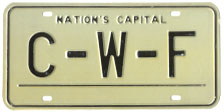 The most noteworthy and unusual characteristics of the earliest D.C. personalized plates relate to the way in which the city's name is displayed. This important feature was conspicuously absent until the plate was validated with a long decal placed below a horizontal rule embossed directly below the registration number. These strip decals, used from 1964 (exp. 3-31-65) through 1967 (exp. 3-31-68) are marked with WASHINGTON, D.C. and the expiration date.
The most noteworthy and unusual characteristics of the earliest D.C. personalized plates relate to the way in which the city's name is displayed. This important feature was conspicuously absent until the plate was validated with a long decal placed below a horizontal rule embossed directly below the registration number. These strip decals, used from 1964 (exp. 3-31-65) through 1967 (exp. 3-31-68) are marked with WASHINGTON, D.C. and the expiration date.
Nineteen sixty-four baseplates appear to be the first of all D.C. plates to have featured the city name as WASHINGTON, D.C. When they were issued in the fall of 1964 other D.C. plates in use were red on white with 3-31-65 embossed in the upper corners and DISTRICT OF COLUMBIA centered at the bottom. (Click here for an image.) Interestingly, however, the personalized plate stickers have WASHINGTON, D.C. printed on them, not DISTRICT OF COLUMBIA. Regular plates issued about six months later in the spring of 1965 (marked 3-31-66) are also marked WASHINGTON, D.C., and when one considers the lead time needed to produce a year's worth of plates it is reasonable to assume that by the time the 3-31-65 vanity plate decals were printed the decision to change the way the city name was displayed on license plates had already been made.
Although a revised plate style with the city name embossed was introduced in early 1968, 1964 baseplates could continue to be used as long as they were properly revalidated annually. One 1968 base pictured below was validated into 1986, and others (of both the 1964 and 1968 styles) were likely used later.
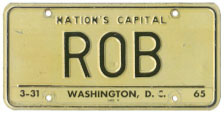 |
This plate exhibits characteristics of the earliest personalized plates and is, in fact, a first-issue. Properly referred to as a 1964 plate, the decal stretching across the bottom indicates the first expiration date for Washington, D.C. plates of this type: March 31, 1965. |
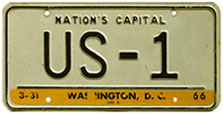 |
Plate US-1 shows the second-issue (1965) sticker, which is the same color as passenger car plates of that year and indicates a 3-31-66 expiration. It was displayed on a Lincoln in the presidential fleet that was used by four U.S. presidents. |
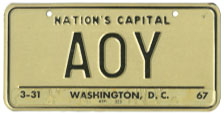 |
This first-issue base was validated for the third year of the District's personalized plate program. Wide dies used to make these plates limited the number of available characters to five. |
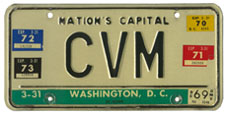 |
The white-on-green 1967 (dated "3-31-68") sticker was the last to be made in the strip format. The small black-on-white 1968 ("69") sticker was used only on vanity plates, hence it is seldom seen. On this plate it has been properly positioned to cover the "68" designation of the 1967 sticker. |
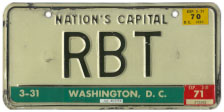 |
Most unusual about this plate is that a die not previously seen on plates of this type was used to emboss the slogan. Note also that the serial number on the white-on-green 1967 sticker is printed on a small white rectangle, to increase its legibility, which is not the case on the sticker applied to plate CVM pictured immediately above. |
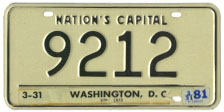 |
Plate no. 9212 is shown simply to illustrate that D.C. drivers are not limited to using only letters on their personalized plates. All-numeric combinations are allowed, too, as long as they are above 1250, the highest reserved-number registration issued. |
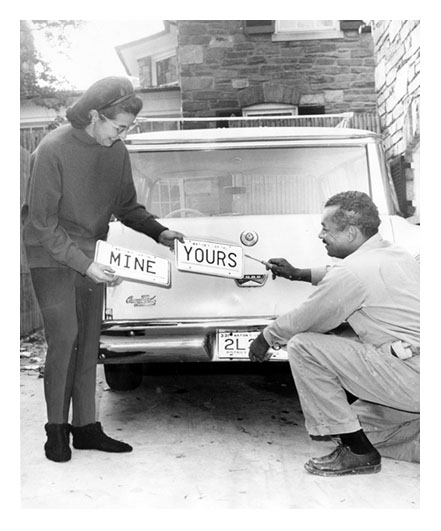 |
When the first personalized plates were distributed no stickers were included, and motorists were told to not use their special new plates until validation stickers were received separately. The left half of this photograph appeared in the October 23, 1964, Washington Star with this caption: "Stickers needed for the personalized District license tags are now available, and Mrs. James C. Walsh of 3005 45th St. NW displays two of her new plates. The Walshes have five cars and five sets of the new tags." The car is a 1962 Ford Falcon. Courtesy DC Public Library, Star Collection, copyright Washington Post. |
Exactly Where Is That Car From?
Imagine how odd it would be to see a plate without a jurisdiction name, like C-W-F above, in use! It was possible in Washington in 1968 and early 1969, and although only a small quantity of "no-name" plates were used for only a short period it's an interesting story that's worthy of being told.
As 1967 drew to a close and plans were made for the March 1968 renewal season, D.C. DMV officials knew that motorists with plates of all registration types except personalized would be receiving new plates for the April 1968-March 1969 registration year. Therefore, dated "69" validation stickers were needed (and were in fact issued) only for personalized plates. For some unknown reason, however, a decision was made to not make them in the "strip" style, with the city name, issued for the previous four years. Instead, the black-on-white 69 stickers are of the same small size and format as the white-on-green dated 68 sticker, the first to be issued in D.C.
These traditional-style 1969 stickers were perfectly adequate when used to validate vanity plates already in use because the black-on-white plates had the city name displayed and still visible on the white-on-green 3-31-68 strip sticker. The '69 issue simply covered the right potion of the older sticker, as shown on plate CVM above. The no-name vanity plates were the result of motorists purchasing new personalized registrations, evidenced with plates without an older strip decal. The problem was identified and corrected rather quickly, on or about Feb. 1, 1968, with plates upon which the city name is embossed (as shown below).
It's impossible to say how many sets of personalized plates were distributed with a '69 sticker and no mention of the issuing jurisdiction. Also impossible is the determination of exactly when and for how long these plates were issued. Because this is such an unusual occurrence in the overall history of U.S. license plates and because it happened so relatively recently, we believe it's worth spending some time and energy to address these questions. If you agree, read on! If you don't, click here to jump over the following discussion.
The determination of exactly when and for how long D.C. vanity plates were issued and used with no jurisdiction name is presently impossible due to uncertainties as to exactly when certain changes were made to them and when stickers of particular registration years ceased to be issued in favor of stickers of the following year. However, we know enough to speculate that only a small quantity of them were used only for, at most, about 14 months. If you consider how relatively few vehicles were registered in Washington, D.C. in the late 1960s, then speculate as to what small percentage of private passenger vehicle owners chose to purchase vanity plates, and then consider that what resulted in these no-name plates being issued was only the purchase of a new personalized registration (not any renewals) during a mid-winter period of what may have been as short as a few weeks, it becomes evident that we're discussing a very small number of plates, possibly not even 50 sets.
It is important to understand that the date shown on D.C. plates and stickers of this era indicates the registration expiration (not issuance) date. For example, personalized plates bearing the white-on-green strip sticker marked 3-31-68 were valid for use from April 1, 1967, through March 31, 1968. More theoretical, because we don't know the facts, is the premise that at some point prior to March 31, stickers (or plates, if applicable) marked "3-31" of any registration year would stop being issued in favor of stickers of the following year. For example, if someone obtained a new personalized plate in Nov. or Dec. of 1967 it came with a white-on-green 3-31-68 sticker. But what if a motorist obtained a new personalized registration and set of plates during February or March? What if their registration was issued on March 25 or 26? Returning to our example, as of some (undetermined) early 1968 date it would make no sense to continue to issue plates with a 3-31-68 sticker that was soon to expire, so prior to the end of the 1967-68 registration year 3-31-68 stickers stopped being issued and 3-31-69 stickers were distributed instead.
Back in the days when registrations were issued annually and their expiration was not staggered, motorists (especially those not prone to procrastinating) were aware of what was commonly referred to as a plate or sticker's "earliest display date." In most jurisdictions, plates and stickers could be displayed no earlier than one month prior to the beginning of their period of validity. In D.C. and most other places that used an April 1 to March 31 registration year, the earliest display date for plates and stickers was March 1. Therefore, we presume, stickers or plates for the upcoming new registration year were almost certainly issued as early as the earliest display date, and possibly before. For example, anyone that purchased a regular D.C. registration during March 1964 received a red-on-white plate marked 3-31-65, not a black-on-yellow plate marked 3-31-64.
An article about the history of Washington, D.C. plates in a 1987 issue of the ALPCA Newsletter indicates that the second-issue personalized baseplate, with the city name embossed, was introduced at the beginning of Feb. 1968. DCplates.net would have expected that prior to this time new vanity plates would have been issued with 3-31-68, not 3-31-69 stickers, preventing the distribution of plates with no indication of the issuing jurisdiction. However, the same article clearly indicates that no-name plates were indeed issued, the presumption therefore being that 3-31-69 stickers were issued in conjunction with purchases of new personalized registrations for some period more than two months prior to the beginning of the registration year. For example, if we assume that new personalized registrations purchased during the first quarter of any year were issued with stickers (or plates) for the registration year to begin on April 1 of that year, then no-name plates were issued for one month, Jan. 1968, after which plates with the embossed city name were issued.
Accompanying a March 1970 Washington Star article about a controversy over a $10 surcharge for personalized plates then introduced is a close-up photograph of a personalized plate, VROOM, in use. It is the 1964 base style, with no indication of the city name with the exception of "D.C." abbreviated in small letters on the 1968 ("69") and 1969 ("EXP. 3-31-70") stickers. This proves that these no-name plates were indeed issued and used, but until additional facts come to our attention about the timing of the introduction of 1968 stickers and (separately) personalized plates with the city name embossed we can only speculate as to for how long they might have been used. Regardless of assumptions made, it is fairly clear that the period was likely relatively brief.
As discussed above, WASHINGTON, D.C. began to be embossed on personalized plates thought to have been introduced in February 1968 due to a change having been made in the style of sticker issued to validate plates of only this type for the April 1968-March 1969 registration year. Plates of this style were issued slightly longer than ten years, until late 1978, but only for new registrations. Older (1964-style) plates could continued to be revalidated throughout the period during which these 1968 baseplates were issued, and both black-on-white plate styles could continue to be revalidated at least into the late 1980s after the next (1978) base was introduced.
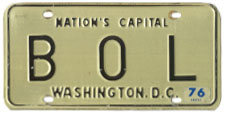 |
This example shows the embossed city name introduced (on plates of this type) in early 1968. Plate B O L is an example of a natural (i.e. new) 1975 (exp. 3-31-76) registration, although due to the combination of plate and sticker styles no expiration date (March 31) is indicated. |
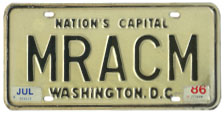 |
The traditional, plain black-on-white format, with wide dies not used on passenger plates since early 1966, continued to be the standard for personalized plates issued through at least the first half of the 1970s. A few are still in use today. |
| Washington, D.C. is the only U.S. jurisdiction that does not offer plates of a distinctive type to amateur radio operators. D.C. plates with ham radio call signs are in fact personalized plates, not examples of a separate type. | |
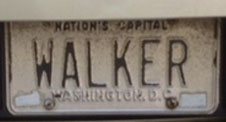 |
This worn plate, photographed in April 2012 after 30-35 years in use, is our only evidence that black-on-white personalized plates were made with the narrow dies used on plates of other types since the mid-1960s. We believe that this plate and others of the same style were made and issued sometime between 1975 and 1978. |
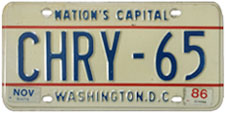 The story of D.C. personalized plates becomes much easier to understand as of late 1978. It was then that this type joined other non-passenger types in being made on the standard-issue plate, which at the time was the new 1978 base. (No vanity plates were made on the 1974 base.) Since late 1978, personalized plates have been made on whatever base was being used for most other plate types at the time they were ordered.
The story of D.C. personalized plates becomes much easier to understand as of late 1978. It was then that this type joined other non-passenger types in being made on the standard-issue plate, which at the time was the new 1978 base. (No vanity plates were made on the 1974 base.) Since late 1978, personalized plates have been made on whatever base was being used for most other plate types at the time they were ordered.
Shortly before the introduction of the 1978 personalized base the wide 1957-66 dies were finally retired. The introduction to vanity plates of narrower dies used to make most other D.C. plates since 1966 allowed the number of characters permitted on them to be increased from five to six. The number was increased to its present level, from six to seven, at some as yet unidentified date between 1978 and 1987.
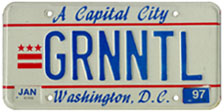
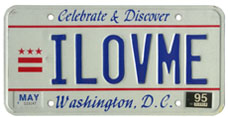
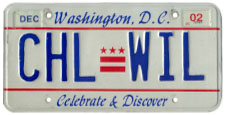
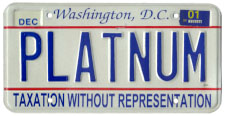
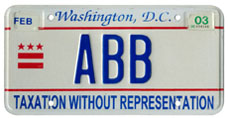
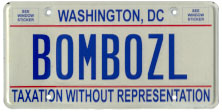
|
This page last updated on December 31, 2017 |
 |
|
copyright 2006-2018 Eastern Seaboard Press Information and images on this Web site may not be copied or reproduced in any manner without consent of the owner. For information, send an e-mail to admin@DCplates.net |

